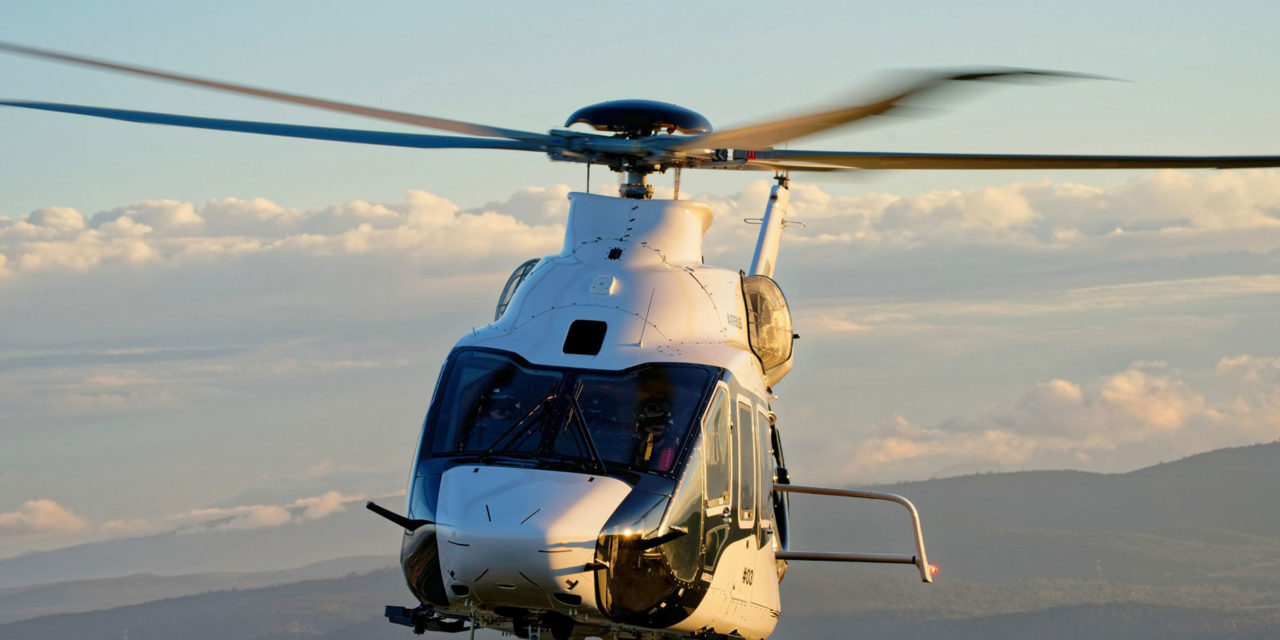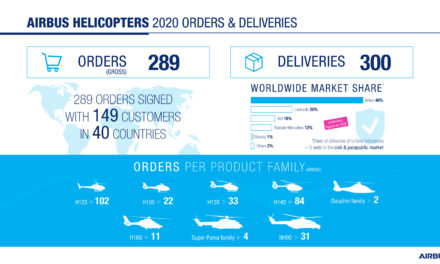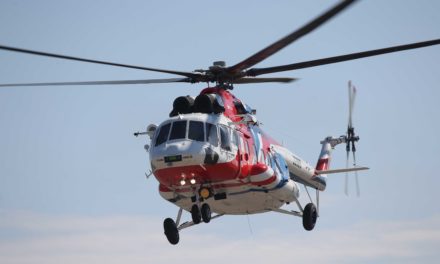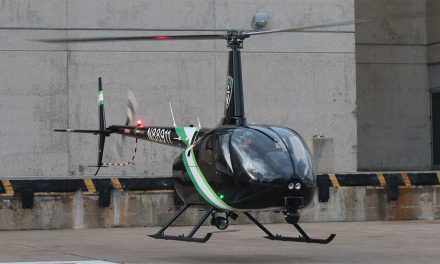Initiated in 2011 with the X4 project, the H160 program has just started the final stretch of the certification phase with three prototypes in service today. The H160 is a new generation helicopter that combines industrial, product and support innovation. Through this revolution, the objective of Airbus Helicopters is to achieve a high level of quality and above all safety. The manufacturer anticipates the first deliveries by the end of 2019 and remains fully confident about the level of maturity it can offer its customers as soon as this new aircraft is commissioned.
The latest manufacturer based in Marignane having reached a level of finalization close to that of series aircraft, I was invited to take the controls of the first new generation helicopter on the market and the first Airbus branded machine: the H160. Passing through the gates of the Airbus Helicopters headquarters site on this morning in early May, seeing where so many commercial successes and innovations have come to light, I was still unaware that I had an appointment with the future and that real technological breakthroughs were waiting me throughout this day.
Presentation and Flight Preparation
When Guillaume Steuer, the media relations manager, greets me, the aeronautical weather conditions are typical of the Marseille region in the spring and ideal for a demonstration flight: visibility beyond 10 km, clear skies, north wind for 15 knots, temperature 14 ° C. The program of the day is dense: safety briefing with the test crew, flying at the controls of the H160, conference on the maintenance program, tour of the assembly line, lunch break, presentation of the digital model and finally presentation of static and dynamic models of the H160. It is therefore without wasting any time that the communications officer takes me to the V8 building where I meet the crew designated for this flight: Olivier Gensse, Chief test pilot of the H160 and Nicolas Certain, flight test engineer, which have both been integrated into this program from day one. I am in the hands of experts in the field who know the H160 inside out. In the preamble to the briefing, Olivier Gensse underlines the fact that, while grouping 68 innovative patents, the H160 has been designed to be simple and intuitive. The objective is to reduce the number of errors related to flight or maintenance and thus increase the level of safety for passengers and crew members. To carry out the development and certification program of the aircraft, Airbus Helicopters has three prototypes. The aircraft on which we will fly today will be the PT1 (F-WWOG), which has the latest validated equipment and an intermediate passenger cabin finish (offshore seats, fabric upholstery, flight test bench). In order to focus on the capabilities of the machine, Olivier Gensse voluntarily chose to take off above the planned certified mass (5669 kg = 12500 pounds) with 5713 kg for this flight. Nicolas Certain adds that a flight manual supplement is being drafted to allow operators who wish to have a maximum takeoff weight of 6050 kg without significant operational limitation. One of the many special features of the H160 lies in the design of its centering. Indeed, unlike many helicopters, the centering diagram is focused on the main gearbox to allow all configurations of the aircraft without penalizing the operator. The worst case being a configuration with full fuel tanks, no or few passengers and equipment in the aft cargo bay. Briefing finished, I follow the crew in the direction of the tarmac where the ground assistance team was waiting for us near the PT1. Having had the chance to fly on most helicopters designed by this manufacturer (for example the Alouette 2, the H225, the Dolphin and the Super Frelon), I look forward to getting acquainted with this concentrate of technology and finally discover a new generation helicopter.
Pre-flight visit
Arriving at the foot of the aircraft, I am pleasantly surprised by the compromise that the designers made between the dimensions of the helicopter and its profile. Although it belongs to the “Medium” category (4 to 6 tons), the size of the H160 is closer to the H175 than that of an H155: the top of its imposing rotor consists of five “Blue Edge” blades culminating indeed to 4.23 meters. The imposing character of the H160 is however largely offset by the fineness of the lines of this machine, whose design was initiated by Peugeot Design Lab and which translates at first glance to the “racer” DNA of this aircraft. While going around the back of the aircraft, I am impressed by the slant and the size of the tail rotor (the largest ever built in series: 1.20 m in diameter) but also by the double fixed horizontal plane which completes all the elements that characterize the technological breakthrough and innovation that symbolize the H160. After a flight safety briefing given by the crew, I sit in the passenger cabin by the wide opening of the side door without any difficulty. The height of the ceiling is comfortable and I reach my seat in the front row of the left side of the device. On my right, Nicolas Certain, will occupy the central square of the cabin in front of his test and measurements desk. Once seated and strapped, I feel quickly at ease: I have excellent visibility through the wide side and forward windows thanks to the imposing windshield. Despite the dark upholstery of this trial version, the brightness remains clear in the cabin and will undoubtedly be optimized on standard versions with a clear color coating. Olivier Gensse tells us that the design of the H160 cabin has been the subject of a large study to improve the quality of travel (reduced stress and fatigue) and to increase passenger safety. To achieve this goal, Airbus Helicopters has focused on increasing visibility, reducing vibration, reducing noise by 50% and providing a quality air conditioning system. For the offshore version, the cabin may be equipped with 12 passenger seats. The large cabin volume bodes well for the future EMS version.
Cabin experience
We are ready to start and as Olivier Gensse announced, the simplicity and security that characterize the H160 will then make their full sense. Visual sign to the track team, battery switch on, 13 seconds for system initialization, anti-collision lights on, both engines are set to IDLE (idle ground) simultaneously for a start. The Helionix integrated system, standard of all the new helicopters in the Airbus Helicopters range, manages the start-up allowing the crew to prepare the flight data (radio frequencies, route in the FMS, etc …). As for the fuel, fire and electrical tests, they are carried out autonomously and in case of malfunction of a system, an automatic shutdown will be generated by Helionix. This new type of start-up allows considerable operational time savings and increased safety, allowing the crew to focus on the outside environment (passengers, personnel, etc.). Only test to be done at the first start of the day: the autopilot test. The two switches of the engines are then switched to the FLIGHT position and we are ready to take off. Total time of implementation: less than 2 minutes! A powerful argument to attract future customers from the oil and gas, search and rescue, EMS or VIP sectors. The taxiing phase, which is often tricky in a helicopter, is greatly facilitated on the H160 thanks to the wide track of the main landing gear but also by the very great flexibility of the orientation of the nose wheel makes it possible to perform surprisingly a U-turn in a confined space on the ground. To complete this aircraft and to ensure visual safety around the aircraft during this phase, the crew can display the image from the camera located at the top of the rear tail fenestron on one of the four screens of the dashboard. This function can also be used in flight to confirm any occurrence of fires or fumes. Now comes the long-awaited moment of hovering. The maneuver is very flexible and the pilot rises to the recommended height of 6 feet. The dual horizontal stabilizer then enters into action and provides, in the conditions of the day, a base of only 2 ° nose-up, which is very pleasant for the visibility of pilots as well as for passengers. The level of vibrations is remarkably weak. Despite the heavy take-off weight of the aircraft, the power margin at the FLI (First Limit Indicator) is consistent, sign that the two Safran Arrano engines of 1100 cv give the H160 more than comfortable power in the conditions of the day. They also reduce fuel consumption by 10 to 15% compared to engines of equivalent power. After a take-off on the ground effect, Olivier Gensse uses the engagement of the higher modes of the autopilot with a double click on the central control of the cyclic stick. The ALT, HDG and IAS modes then appear on the FND screens. All that remains is to adjust the desired values thanks to the “bip trim” located on the flight controls. At the end of the climb towards the Sainte-Victoire mountain the aircraft is stabilized at an altitude of 3000 feet QNH and after a few seconds at the maximum continuous power, the cruising speed reaches the value of 150 knots of TAS (True Air Speed). The fuel consumption with these parameters (low layer) is then 395 kg / h. Cruising at 8000 feet, it reaches 320 kg / h. The full internal fuel reaching the value of 1120 kg, the autonomy of the H160 is around 400 nm in standard IFR reserve included. Cabin side vibration level is very low. In order to evaluate the low internal noise level, we remove our radio headsets at the request of Olivier Gensse. Unbelievable! It is possible to communicate without difficulty. A real revolution due in part to the design of the main rotor (Blue Edge blades) and the permanent management of the rotor speed. We almost forget that we are flying in a helicopter at nearly 300 kilometers per hour. Once arrived in the work zone, Olivier Gensse decides to simulate an unusual position following an uncontrolled pilot maneuver (passage in layer, loss of external references). The helicopter is positioned in a strong nose-up with a large inclination. A double click on the “recovery” command of the cyclic stick engages the modes of stabilization ALT, HDG, IAS and allows to put the aircraft right and safely in a record time and to find a configuration of stable flight. During a flight a pilot may be required to perform a maneuver to avoid an obstacle, another aircraft or birds. These maneuvers generally require fast and sometimes brutal action on flight controls. In this kind of changes the control system is under severe stress and the result is very often a loss or surplus of rotor speed, an overtorque on the main gearbox, or even exceeding the engine limitations. Olivier Gensse wishes to highlight the qualities of the H160 in this area by simulating a very fast variation of the collective stick. Towards the maximum pitch at first, then towards full pitch. In spite of the violence of the collective actions, during this demonstration, the rotor speeds are perfectly regulated as well as the motor parameters: a revolution in terms of safety and this in all flight fields. I admit to being literally stunned by the capabilities of the H160 in this area. We then head for the small grass field of Berre La Fare a few nautical miles from the Marignane airport and while the pilot carries out the integration on the ground, Olivier Gensse performs the actions before landing. After taking an approach following a clear terrain profile in performance class 1 (public transport type), we land and cut the engines.
Taking charge
Olivier Gensse invites me to take a seat in the cockpit. I open the wide door right side using an integrated handle directly from the automotive design. Several details draw my attention: more than 50% of the surface of the door is glazed, a place for storing documentation or equipment was planned in the lower part inside, and like for the H175, an inside visual indicator and an external repeater make sure that each door is closed at a glance: green = locked, red = not locked. The installation in the cockpit is easy and the adjustment controls of the seat and rudder are accessible and easy to use. Olivier Gensse advises me to adopt a position so that my eyes in the extension of the dashboard cap. Once installed, which contrasts with previous generations of helicopters, it is the vast visual space that has been devoted to the outside. Large glass surfaces, the right edge of the dashboard stopping along the cyclic axis, beveled windscreen pillars: everything has been designed to maximize the visibility of the pilot and safety. The upper part of the cockpit includes the so-called “configuration” commands (Electricity, engine controls, fire extinguishers, rotor brake, etc.). A new ergonomics wanted to separate this space from the so-called “vehicle” (train, nose wheel, park brake, autopilot, FMS, etc. ..) located on the center console. As part of crew work and to optimize the concept of CRM, when a pilot directs his hand to this space during flight, this action will be synonymous with reconfiguration following the malfunction of a system. The only exception to this philosophy is the rotor brake which is also on the ceiling. The head test pilot proceeds to a new start and 1 minute 30 later we are ready to hover. I cannot hide my smile when I hear on the speaker “take the controls”. Right from the application of the collective, I perceive a pleasant lightness in the controls despite the 5500 kg weight of the device. I then use the double-click function on the central cyclic control to engage the Ground Turn Coordinator Hover (GTCH) mode, which allows to perform a stationary which is fully operated using autopilot couplings. This function used in short final when in dust or in the snow allows stabilization in safety before landing. The program we established with the crew before the flight, provides a simulation of engine failure during a CP1 type takeoff (takeoff profile on the hospitals’ DZ for example). The failure will be simulated by Olivier using the training mode at 70 feet.
The H160 put to the test
I take off with a slight decline to keep a visual on the DZ. As soon as the audible alarm of the engine failure sounds on the on-board speaker, I look at the FLI and very slightly drop the collective pitch in the zone corresponding to the valid emergency engine speed (OEI) to keep the rotor speed. The descent to the DZ is flexible and the contact with the ground is soft despite the high mass. This failure which on many helicopters requires manhandling on the part of the pilot, becomes very accessible thanks in part to the very high efficiency of the main rotor. During my previous career I flew on Dauphin N (also equipped with a fenestron) and I remember having to reach quite quickly the control stop of the rudder during sideways translation or stationary crosswind. So I am curious to see how the H160 behaves with such a big window in this kind of configuration. I ask Olivier Gensse to give us a demonstration in this flight configuration. Facing the wind, at a height of about 20 feet, we leave first to the left (the worst side in terms of power required). We quickly reach the speed of 53 knots, the rudder barely reaching their control stop. On the right side we will stop at 45 knots for lack of space on the track. Evidence that despite an imposing fenestron and a consistent vertical fixed plane, the H160 is able to cope with stationary sidewind speeds well beyond the capabilities of previous aircraft. In the continuity of the part “ground work” and with the agreement of Olivier, I take the orders to carry out what one calls in the language of helicopterist: a “waltz”. The goal is to understand the behavior of the machine when combining a rotation and a translation. During this maneuver, I immediately perceive a great homogeneity and a pleasant fluidity in the controls, offering an ease to realize this specific exercise in terms of coordination. Former pilot of the French Navy Aviation, I am particularly sensitized to the aeromaritime operations in helicopter. This is why I want to simulate the conditions encountered during winching with the H160. I chose to do a stationary at 70 feet. Once stabilized thanks to the GTCH coupling, I look down to the right of the camera and find good visibility by the wide pilot window and at the feet. Engineers have also planned a window called “bad weather”, convenient when the rain degrades lateral visibility. The distance between the pilot seat and the door is acceptable and allows you to lean to the right to increase the visual of the reference point without letting go of the controls. In addition, since the H160’s stationary wind limit diagram is relatively wide, the pilot will not be obliged to orient the nose of the aircraft in the relative wind, which will enable him to obtain better references for winching. For the next exercise, I want to simulate a stationary engine failure without ground effect and use the “Go Around” function of the autopilot. This function makes it possible, among other things, to manage the trajectory and the limitations of the machine in this type of case. I then go up to 100 feet hovering and as soon as Olivier Gensse generates the fault with the Training switch, the engine failure alarm sounds and triggers the GA button located on the collective stick. The autopilot positions the aircraft immediately on a “Fly Away” trajectory with a 20 ° pitch attitude while managing the collective power available. My hands are close to the controls and allow automation. Once the take-off safety speed is reached (45 knots), the aircraft takes a climb path and displays the maximum available power. Cleared of obstacles, the aircraft is then reconfigured by Olivier. This autopilot feature, which also exists on other Airbus Helicopters, significantly enhances the level of safety offered by the H160.
Exceptional flying qualities
The H160 is expected to equip the French armed forces in the coming years as HIL (Light Joint Helicopter), the time has come to attend for a demonstration of maneuverability. I wish indeed to realize the capacities of this helicopter to evolve tight in its field of flight. Olivier being the most qualified to realize this kind of evolution takes the controls. The evolution begins with a leveling of speed, followed by a high nose up without load factor to reach a 70° attitude and a reversal by a sharp left turn. After level stabilization, Olivier performs a “quick stop” maneuver (very strong nose to stop the aircraft in hover mode). From the stationary position, he continues by displaying a pitch plate of 80 °, and installs the aircraft downhill while pointing the nose to the left in a spiral. The evolution ends with a flexible resource without lighting of the “Limit” warning light and the audible alarm which are triggered for a load factor of 2g. I admit that I have never evolved in this way by helicopter with a weight close to the maximum and with such a feeling of security. Despite the tight developments, no limitation has been reached. Military pilots will certainly appreciate the H160’s broad evolution capability, which for a civilian helicopter seems to be closer to that of a military machine. The great flying qualities of the H160 can be explained mainly by the work done by the development teams on the main rotor, the flight controls and the autopilot, underlines Olivier Gensse, who tells me on the onboard phone about the H160’s rotor: “If you ask it, it will do what you ask it to“. One of the first missions of the H160 will be to carry passengers and ensure their safety throughout the flight. That is why before leaving the field of Berre La Fare, I ask Olivier if I can perform an interrupted take-off procedure. I then hover, focused on the grass strip to simulate a departure of a land refered to as “cleared”. We will take 50 knots as decision speed. Olivier Gensse will simulate the engine failure before this speed. I take off and double gong sound of the engine failure alarm, I announce “Reject” on the phone on board. I display a pitch attitude around 12 ° to decelerate while maintaining a height of about 15 feet. Once the ground speed is less than 40 knots (maximum speed of touching the wheels) I give hand over the controls and touch the ground before a little area at the front. I brake for a few meters. The exercise was conducted with incredible flexibility and efficiency. Rotor efficiency and forward visibility play an important role for safety in this kind of emergency procedure.
Soft landing
It is already time to return to Marignane. Once the level stabilized at 2000 feet QNH, and on the advice of Olivier, I put the H160 in slight descent to reach the VNE (170 knots). The behavior of the aircraft and the vibration level show no change with respect to the cruise. A “real flying carpet”! During the integration in north downwind for the 31 straight runway at Marignane, Olivier performs the check list before landing and lowers the control pallet of the landing gear which has the particularity of being electric and without speed limit for its use. Six seconds later the 3 green arrows appear on the dashboard. Authorized to land, I cut the autopilot casting and line up in the long final for a rolled landing. To avoid the phenomenon of shimmy when sitting, (resonance of the nose gear in contact with the ground) one locks the nose wheel on all helicopters with wheels. To avoid any forgetfulness and still for the sake of simplicity and security, on the H160, the rolled landing is planned without this lock. Thanks to the low pitch attitude of the H160 I keep a very good visual of the runway throughout the approach and deceleration phase. The wheels of the main landing gear touch the ground at 40 knots. I operate the electric brakes located at the top of the rudders my heels to the floor: another innovation very practical for pilots. As we enter the parking lot, Olivier Gensse; after warning me, turns on the parking brake while we are driving! Unthinkable on a conventional helicopter. The braking is linear and the machine stops firmly but without brutality. Thanks to this device a sudden obstacle can be avoided. A major innovation in terms of safety. Back on our starting spot and after automatic refocusing cyclic and pedals, the engine shutdown sequence is performed as simply as for the start-up.
Coming down from the H160, after 1h20 of flight, I have the feeling of having flown in a helicopter designed for pilots and passengers, in a serene working atmosphere, combining performance and security. Accustomed to glass cockpit helicopters and the phenomenon of “cockpit fascination” associated with these new instrumentations, I realize that contrary to usual I spent 80% of the flight looking out rather than being attracted to inside! Taking into account the users’ constraints (pilots, operators and passengers) and the return to basic notions of flight associated with the latest generation technologies make the H160 a welcoming, high-performance work platform with a very high level of security. All the conditions seem to have come together to offer the H160 a brilliant civilian and military career. And to resume part of the slogan of the manufacturer: “Do not look elsewhere, the future is here.”
By Olivier Mabille
©AIRBUS HELICOPTERS
















